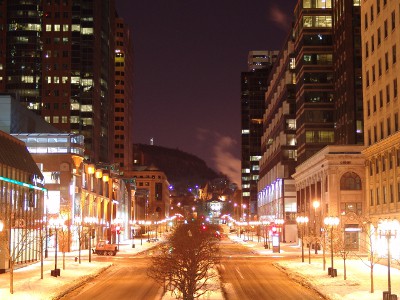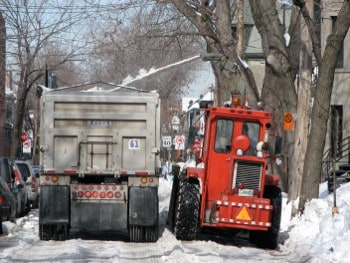
 In October, news leaked that the city of Montreal is going to seriously study the idea of installing heated sidewalks along Ste-Catherine Street West, the main downtown artery.
In October, news leaked that the city of Montreal is going to seriously study the idea of installing heated sidewalks along Ste-Catherine Street West, the main downtown artery.
Heated sidewalks, you say? Sure, that kind of pie-in-the-sky technology might work for Japan and Sweden and Iceland and Bill Gates’ house, or some outport like Holland, Michigan, but definitely not in Canada. Taxpayers won’t stand for it, even if it’s demonstrated to significantly reduce the snow removal budget as well as costs associated with slips and falls on icy sidewalks that result in hospital visits and missed time at work.
Occasionally you wonder whether the people who say that Canadians can’t have nice things aren’t just saying that we don’t deserve them.
Meanwhile, heated sidewalks in Canadian cities may be an idea whose time has come.
Westmount mayor Peter Trent responded favourably when a citizen floated the suggestion at a city council meeting last week.
“Years ago, when it was first suggested, I did not think much of it,” he told the Westmount Examiner. “But in the last six months, I have been coming around. When I look at the cost of snow removal, salt, health issues related to iced sidewalks, I begin to think sidewalk heating makes a lot of sense.”
Sapporo, Japan, with its heated sidewalks, is the second snowiest city in the world, according to AccuWeather, recording 4.85 meters on average, with Aomori, Japan coming in “first” (at 7.92 meters). St. John’s, Newfoundland comes in a respectable fourth (at 3.32 meters).
This has been a record-breaking winter for Japan, though, with 1.8 meters falling in Hokkaido last week during a single snowfall.
“In Northern Japan, they had 18 feet of snow this year so far,” continues Mayor Trent. “Yet, you can see parents with strollers, as well as old gentlemen and ladies holding hands, walking in sidewalks completely free of snow and ice. Sidewalk heating would be a great step forward and a great example for the rest of this country.”
At the moment in Montreal, you’d be better off on skis than getting around by foot or car. There are no babies in strollers and definitely no old gentlemen and ladies holding hands.
This is no winter for old men. It’s more like a snow-bound version of the Road Warrior films.
Occasionally you wonder whether the people who say that Canadians can’t have nice things aren’t just saying that we don’t deserve them.
Montreal’s first major storm of 2015, during the weekend of January 4, turned the sidewalks into skating rinks, triggering a spike of broken wrists and ankles, each of which required a visit to a hospital emergency room by ambulance.
Mayor Trent’s belief that heated sidewalks may alleviate “health issues related to iced sidewalks” begins to make financial sense when you cost out what those issues are.
Ambulance rides, to begin with, aren’t free. Manitoba’s Prairie Mountain Health region, which takes in the Assiniboine region, bills $530 for an ambulance. In Winnipeg, it’s $512. In Alberta, the bill is $250 if you’re treated at the scene and $385 if you’re taken to hospital, with a $200 surcharge if you’re from out-of-province. Ontario is a steal at $45, with a $240 surcharge if your trip is deemed medically unnecessary.
In Canada, the number of hospitalizations due to falling on an icy sidewalk between 2006 and 2010 was as low as 6,443 and as high as 9,121.
Hospitalization rates vary by province as well as by hospital, and also depend on whether you’re an uninsured resident or an out-of-towner, but a stay at Vancouver General’s daily ward will set the taxpayer back $3,235 per day or $8,120 for a day in intensive care, while a simple visit to the emergency room followed by a quick discharge costs $765. Day care surgery for a non-resident costs $1,107.
The Ontario Injury Prevention Resource Centre estimates that for every hospitalization, there are over 10 visits to an emergency room that don’t require a hospital stay. In fiscal year 2005-2006 in Ontario, there were 2,038 hospitalizations for falls on ice, and 21,213 emergency room visits.
That’s just the hit to the healthcare system. It adds up pretty quick. Now let’s talk about snow removal.
 That first snow event of the year cost the city of Montreal an estimated $20 million in snow removal operations. The city’s crews function like an army, blowing snow into the back of trucks which then drive off and dump them either in the river or empty spaces around town.
That first snow event of the year cost the city of Montreal an estimated $20 million in snow removal operations. The city’s crews function like an army, blowing snow into the back of trucks which then drive off and dump them either in the river or empty spaces around town.
Multiply that by every single snow event, and you start wondering whether we might not be able to achieve better living through a little design.
As Mayor Trent points out, aside from the cost to the healthcare system and then for snow removal, there’s also the cost of salt. Yes, the salt itself costs money, but then there’s the additional cost of damage wreaked by salt on infrastructure.
In the United States, $2.3 billion per year is spent on snow removal, with an additional $5 billion per year cost to the system to repair the effects of salt destroying existing infrastructure.
There are also hidden costs associated with salt, like dead fish in rivers, dead trees along roadsides, and dead zones in lakes.
It isn’t only Montreal that’s considering heated sidewalks. Saskatoon and Edmonton have seriously mooted the idea politically, with Saskatoon going so far as to incorporate the idea into their Saskatoon City Centre plans.
So how will these heated sidewalks actually work? It depends on the city.
In Reykjavik, they’ve got natural underground heat owing to the fact that they’re sitting on an endless amount of geothermal volcanic activity.
Oslo, Norway, just uses electricity, while Luleå, Sweden, redirects excess heat from their steel mill.
Holland, Michigan uses waste heat from its local power plant.
Westmount Commissioner of Public Works and Utilities Patrick Martin wonders whether they might not be able to use waste heat from the local ice rink refrigeration system, or whether there’s an excess of heat stored in civil buildings.
In Montreal, we’ve already got a vast underground steam system.
Everywhere else, there’s thermal energy available to anyone willing to dig for it.
“When I look at the cost of snow removal, salt, health issues related to iced sidewalks, I begin to think sidewalk heating makes a lot of sense.” – Westmount Mayor Peter Trent
Montreal, already in the midst of a long and punishing winter, is emerging from a different sort of longer-term, more existential depression.
We are finally, after decades of being identified as Canada’s “most corrupt” jurisdiction, talking about “smart cities” and using technology to improve urban life, an idea that only two years ago would have drawn scorn from the average Montrealer as yet another scheme to line the pockets of a bunch of crooks on both sides of the law.
During two and a half grueling years of unforgettable testimony, via the Charbonneau Commission, we met a cast of characters from Montreal’s criminal demi-monde, including a charmer nicknamed Mr. Sidewalk.
He was not named Mr. Sidewalk because he was really good at building sidewalks. No, he was called Mr. Sidewalk because you might find yourself underneath a sidewalk if you didn’t do like Mr. Sidewalk asked you to.
The light cast by the Charbonneau Commission has finally exposed crooks like this, while also putting handcuffs on quite a few previously respectable operators. Gilles Vaillancourt, the mayor of Laval for 23 years, now enjoys the hospitality of prison on charges of gangsterism and corruption.
And with that, there’s a palpable sense of relief in the air.
It may be the cabin fever talking, but Montreal, for the first time in decades, feels optimistic.
The city’s 375th anniversary, in 2017, is just around the corner. There’s even talk of the Expos coming back.
It is just possible, with the implementation of daft ideas for improving urban life like smart bus shelters and using Big Data to make services more efficient and installing heated sidewalks, that people might think of something else when they hear the word “sidewalk” other than a Sicilian thug in a cheap suit.
After decades of relative hopelessness about the future, we may even deserve it.
Leave a Reply
You must be logged in to post a comment.



 Share
Share Tweet
Tweet Share
Share




Comment